
Don Cohen, Managing Editor
Every NASA project is a collaboration. A few, like the microsatellite development at Marshall Space Flight Center (see “FAST Learning”), are carried out by a small group at one location, but still depend on the cooperative efforts of engineers, scientists, and managers with different skills and responsibilities.  Most involve teams at space agencies, corporations, and universities around the world. International participation in space science and exploration is becoming the norm.
Most involve teams at space agencies, corporations, and universities around the world. International participation in space science and exploration is becoming the norm.
That trend partly has to do with money. Space programs are expensive; many only happen when costs are shared. More important, though, is shared expertise. As Laurence Prusak says in “The Burden of Knowledge” (“The Knowledge Notebook”), no single individual or institution can know everything important about any subject. Increasingly, accomplishments in science and technology bring together the knowledge of many and diverse people. Connecting and coordinating that diversity are key to the future of aerospace.
Both the demands and benefits of international cooperation spring from differences among partners—the differences in ways of working and thinking that must be understood and negotiated also generate a robust variety of ideas. Several articles in this issue of ASK consider those demands and benefits. In the interview, Steve Smith talks about his eight years as NASA’s space station liaison to the European Space Agency. His earlier experience as an astronaut contributes important practical knowledge to discussions of plans and procedures, but the heart of his job is understanding and respecting how NASA’s international partners work (and earning their understanding and respect). Kathy Laurini (“International Partnerships for Space Exploration”) emphasizes the importance to these collaborations of building relationships and understanding cultural differences over time.
Laurini makes clear that the only way to learn to work together is to work together. She describes how a series of Russian–American missions built a foundation of trust and understanding that made their International Space Station partnership possible. The International Project Management Committee, discussed in “Weaving a Knowledge Web,” was formed to bring together members of space agencies and related institutions because its founders recognized the importance of sharing knowledge and the fact that it could only be shared through relationships developed by joint work.
Which suggests a familiar ASK theme: learning by doing. Another aspect of the burden of knowledge, especially at the frontiers of science and technology, is that you can’t understand things just by thinking about them. You learn the most from unanticipated results and problems that arise in the course of doing real work. So Adam Harding explains the role of mistakes in his professional development (“Learning to Be an Engineer”), and Howard Ross, in “Human Spaceflight and Science,” describes how a simple experiment led to improved spaceflight safety and unexpected benefits on Earth. In “Delivering Clean, Affordable Power,” Bo Schwerin offers another example of an unforeseen return on research, in this case a technology for producing oxygen and hydrogen on Mars that can generate clean energy on Earth. One of the great things about working at the leading edge of science and exploration is that you don’t know what you’ll find until you get there.
Write to the Author
- Contact Don Cohen
More Articles by Don Cohen
- In This Issue (ASK 42)
- Interview with Rüdiger Süß (ASK 42)
- Applied Knowledge: NASA Aids the Chilean Rescue Effort (ASK 41)
- Interview with Jill Prince (ASK 41)
- In This Issue (ASK 40)
- + View More Articles








